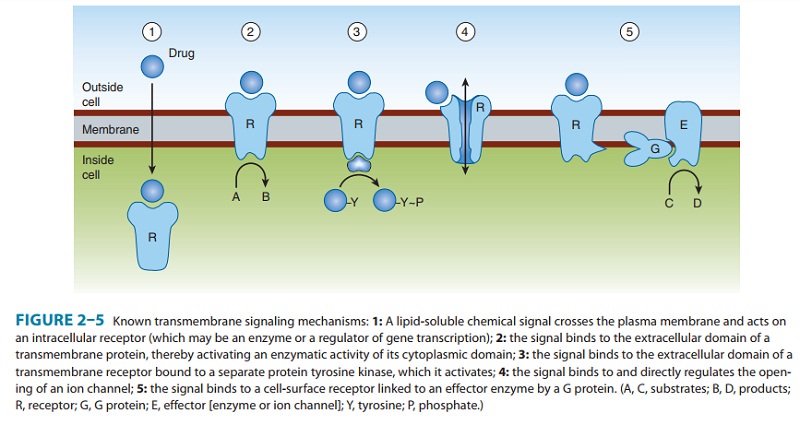Chapter: Basic & Clinical Pharmacology : Drug Receptors & Pharmacodynamics
Signaling Mechanisms & Drug Action

SIGNALING MECHANISMS & DRUG
ACTION
Until
now we have considered receptor interactions and drug effects in terms of
equations and concentration-effect curves. We must also understand the
molecular mechanisms by which a drug acts. Such understanding allows us to ask
basic questions with important clinical implications:
Why do some drugs produce effects that persist for minutes,
hours, or even days after the drug is no longer present?
·
Why do responses to other drugs diminish rapidly with pro-longed
or repeated administration?
·
How do cellular mechanisms for amplifying external chemical
signals explain the phenomenon of spare receptors?
·
Why do chemically similar drugs often exhibit extraordinary
selectivity in their actions?
·
Do these mechanisms provide targets for developing new drugs?
Most
transmembrane signaling is accomplished by a small number of different
molecular mechanisms. Each type of mecha-nism has been adapted, through the
evolution of distinctive pro-tein families, to transduce many different
signals. These protein families include receptors on the cell surface and
within the cell, as well as enzymes and other components that generate,
amplify, coordinate, and terminate postreceptor signaling by chemical sec-ond
messengers in the cytoplasm. This section first discusses the mechanisms for
carrying chemical information across the plasma membrane and then outlines key
features of cytoplasmic second messengers.Five basic mechanisms of
transmembrane signaling are well understood (Figure 2–5). Each uses a different
strategy to circumvent the barrier posed by the lipid bilayer of the plasma
membrane. These strategies use (1) a lipid-soluble ligand that crosses the
membrane and acts on an intracellular receptor; (2) a transmembrane receptor
protein whose intracellular enzymatic activity is allosterically regulated by a
ligand that binds to a site on the protein’s extracellular domain; (3) a
transmembrane receptor that binds and stimulates a protein tyrosine kinase; (4)
a ligand-gated transmembrane ion channel that can be induced to open or close
by the binding of a ligand; or (5) a transmembrane receptor protein that
stimulates a GTP-binding signal transducer protein (G protein), which in turn
modulates production of an intracellu-lar second messenger.Although the five
established mechanisms do not account for all the chemical signals conveyed
across cell membranes, they do transduce many of the most important signals
exploited in pharmacotherapy.

Related Topics